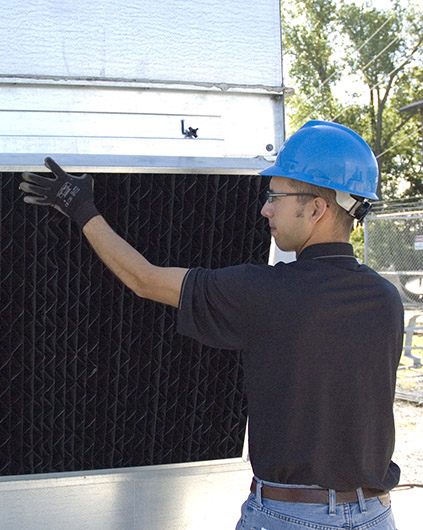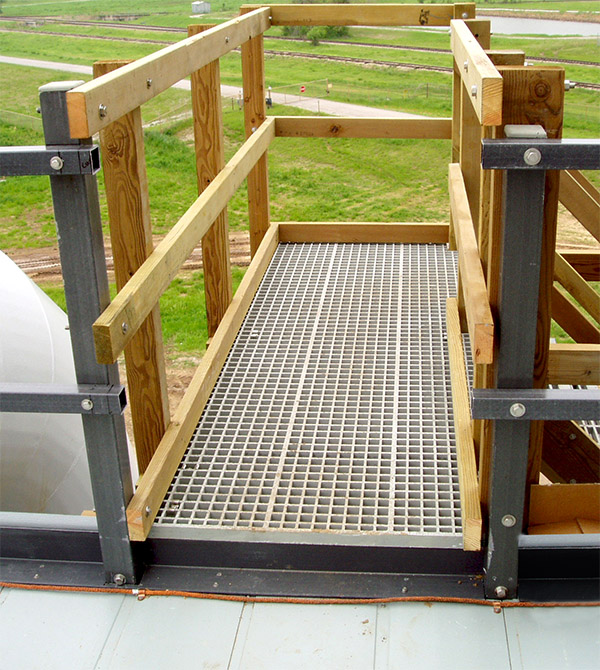冷却塔检查技巧
安排定期、彻底的检查是保证冷却塔效率和寿命的重要步骤。
填写完清单后,请使用结果来帮助规划冷却塔的维修和保养。如果您对冷却塔有具体问题,请务必参阅冷却塔的用户手册。您的 Marley 销售代表将很乐意为您提供零件和服务方面的帮助,或指导您找到合格的服务承包商。
使用我们的在线代表查找器,或者使用此检查申请表!
下载清单
今天安排检查!
使用此表格申请冷却塔检查,您当地的
马利® 代表将与您联系并提供更多信息。
安全与健康
在开始冷却塔检查之前,重要的是确定与工作相关的所有潜在安全和健康隐患,并确定如何消除或控制每种隐患。提前规划有助于提醒工人注意潜在的安全隐患并采取适当的预防措施。始终遵守当地政府发布的安全和健康法规。使用以下一般准则来保护工人的基本安全。
个人防护装备
始终遵守当地有关个人防护设备 (PPE) 的安全与健康法规。冷却塔工人至少应佩戴安全帽、安全眼镜或护目镜、工作手套和防滑高帮皮靴。应根据需要提供防坠落保护。当需要攀爬冷却塔结构时,工人应配备全身安全带和两条至少六英尺长的减震系索。两条系索允许移动,同时始终提供防坠落保护。安全带或单条系索系统不能提供足够的防坠落保护。
冷却塔卫生
不洁净的冷却塔会放大有害生物因子。根据 ANSI/ASHRAE 标准 188 和指南 12,定期检查运行中的冷却塔是否具有良好的生物控制,并制定积极的水处理计划非常重要。检查应至少包括对水和配水盆状况的目视评估。水干净清澈,水线以下没有绿藻或褐藻,则表明生物控制良好。水浑浊、肮脏或有异味,则表明控制不佳。还要注意铁锈色的腐蚀“口袋”。这些口袋可能充满了闻起来像臭鸡蛋的黑色液体。如果观察到的状况表明生物控制不佳,则应彻底清洁冷却塔并评估水处理系统。清洁的冷却塔是通过进行生物测试和使用有效的生物控制程序来实现的,这也可以减轻腐蚀和结垢。
检查
塔壳
检查是否有泄漏、裂缝、孔洞或一般损坏,包括相邻面板之间的漏气。确保将外壳连接到结构的硬件紧固且状况良好。检查钢外壳是否有腐蚀或水垢堆积,检查木质外壳是否有木材腐烂的迹象,包括软腐或胶合板分层。检查玻璃纤维外壳是否有脆性或开裂的迹象。确保检修门处于良好的工作状态,并且塔运行时检修门紧密关闭。如果预算允许,请考虑立即更换 ACB(石棉水泥板)外壳,无论其状况如何。在处理和/或处置 ACB 或 ASB 材料时,建议您联系联邦机构、OSHA、EPS 以及当地和州机构,以获取有关处理和处置石棉废物的具体州法规和要求的信息。
结构
检查钢塔结构是否有腐蚀迹象,特别是金属是否有损失。抽查螺栓接头的紧固程度。仔细检查镀锌钢塔焊接接头附近是否有腐蚀迹象。寻找木材损坏的迹象,包括木构件的贯穿裂纹、断裂或腐烂。用目视和锤子敲击检查木构件。沉闷的低音表示木材柔软,而高音调的尖锐声音表示木材坚固。如果发现软点,请用冰镐或类似设备仔细探测。特别注意钢或铸铁紧固件和连接器周围的木材,以及柱子的底部。抽查螺栓结构接头的紧固程度。检查接头连接器是否有腐蚀或其他损坏迹象。检查玻璃纤维或塑料塔的组装接头,确保硬件紧固且状况良好。寻找结构撕裂或开裂的迹象。
检查风扇甲板材料的总体状况,注意是否有任何钢材腐蚀或木材腐烂。确保风扇甲板支撑构件状况良好,并且风扇甲板和支撑件之间的连接牢固。检查相邻风扇甲板面板之间是否有漏气。松散的风扇甲板覆盖层有绊倒危险。确保覆盖层正确安装,并且覆盖层材料状况良好。无论情况如何,都应考虑立即更换 ACB 覆盖层。
楼梯
寻找木材腐烂或钢材腐蚀的迹象。检查踏板、扶手是否松动或纵梁是否损坏。确保所有螺栓连接均紧固,且五金件状况良好。
梯子和扶手
检查材料的总体状况,确保梯子和塔架之间的所有连接都牢固且状况良好。检查钢梯和铝梯上的焊缝。
室内走道
检查木质或玻璃纤维走道上是否有破损或磨损的踏板和栏杆。检查钢制走道是否有腐蚀迹象。检查走道和塔架结构之间的连接是否紧密。特别注意任何可能对操作和维护人员造成潜在安全隐患的损坏或磨损。
冷水盆
检查是否有过多的污泥和堆积的碎屑,这些可能为细菌提供理想的滋生地。检查水槽、水槽滤网和防气蚀装置(如果使用)的状况。水槽滤网应无垃圾。特别注意冷水盆组件中是否有腐蚀或金属损失。仔细检查木质、钢质和玻璃纤维盆是否有任何泄漏或密封材料破裂的迹象。
配水盆地
检查基础材料是否损坏。检查木材是否腐烂,检查钢材是否腐蚀。检查相邻面板之间是否有泄漏。检查盆支撑构件的完整性。检查钢或玻璃纤维盆中螺栓接头的紧密性。
管道
检查铁管是否腐蚀和涂层材料是否脱落。检查所有支撑件,确保其完好无损,以便继续使用。抽查是否有泄漏以及螺栓接头是否紧固。检查 PVC 或玻璃纤维管是否有损坏迹象。
盆式流量控制阀
检查阀门组件是否有腐蚀或磨损迹象。手动操作阀门,使其达到其整个行程范围,然后重置阀门,以平衡所有水盆部分的水流。
喷嘴
检查是否有堵塞或内部磨损迹象。如有必要,暂时移除喷嘴并将其拆开以检查内部是否堵塞。确保所有喷嘴组件(如可拆卸防溅板)都已安装到位并正常工作。检查是否有因腐蚀或侵蚀而导致的材料损失。检查与支管或配水盆底板的连接是否充分。
填充通常有两种类型:飞溅和薄膜。
溅水填料由各种形状的木条或塑料条组成,以固定的间距和方向支撑,通常使用金属丝或玻璃纤维网格。陶瓷砖是另一种溅水填料。对于每个溅水填料,请检查溅水条本身的状况。检查是否有下垂、破损或腐烂的溅水条或过多的水垢堆积。还要检查是否有掉落或错位的溅水条。确保所有支撑网格都已安装到位,并在塔内均匀分布。检查钢网格上的涂层、不锈钢丝网格上的焊缝状况以及玻璃纤维网格的一般状况。如果网格的某一部分显示出过度损坏,则应更换。此外,请检查支撑网格本身的塔构件。如果您需要订购零件,请注意以下事项:
- 防溅条和格栅的材质
- 相邻防溅条之间的水平和垂直间距
- 防溅板是否与百叶窗面平行或垂直安装
- 防溅杆的形状(木条、T 型杆、V 型杆、M 型杆、半圆形等)
薄膜填料由多片平行形成的薄片组成,它们要么悬挂在塔内,要么搁置在固定的支撑构件上。检查薄片表面是否有水垢、藻类或其他污染物堆积。还要检查是否有侵蚀、下垂、薄片撕裂或冰损坏的迹象。检查支撑构件的状况。如果您计划订购零件,请注意薄片材料和间距。无论哪种情况,请考虑立即更换石棉填料。您将受益于现代高效填料设计提供的改进性能。
除雾器
除水器的清洁度和有效性可最大程度地控制水量并大大减少漂移物排放。确保所有空气通道均无杂物,并尽可能保持清洁。检查所有组件是否正确安装。检查密封件的状况,以确保水不会通过损坏或缺失的密封件绕过除水器。木质叶片和框架易受恶劣条件影响,应检查是否腐烂。如果您需要订购更换零件,请注意除水器的材料和配置。主要类型是木质叶片、塑料叶片和 PVC 蜂窝配置,包括在填充板上模制的除水器。
百叶窗
确保所有百叶窗都安装到位。检查基材是否有任何损坏,例如木材腐烂或钢百叶窗腐蚀。检查是否有过多的水垢堆积或生物生长。检查百叶窗支撑构件的状况,以及百叶窗(支撑)与塔本身之间的连接状况。注意百叶窗的材料、布置和垂直间距。典型的种类包括胶合板、钢、ACB、玻璃纤维和模制在填充板上的蜂窝结构。无论状况如何,都应考虑立即更换 ACB 百叶窗。
皮带传动风扇系统
检查滑轮的状况,检查滑轮槽或腹板上是否有腐蚀或金属损失。确保将滑轮固定在轴上的衬套紧固且状况良好。检查皮带张力和对准度是否正确。查看磨损迹象,例如裂纹和划痕,这表明应该更换皮带。检查风扇轴轴承润滑剂,如有必要,请重新润滑。确保轴和密封件状况良好。检查轴承是否松动或损坏。确保轴承箱和支架之间的所有连接紧固且状况良好。检查支架本身是否有腐蚀或其他损坏的迹象,并检查支架和塔架结构之间的连接紧固度。
减速机® 齿轮传动
关闭风扇,检查油位并根据需要添加或更换油。排出油样并查看是否有水、金属屑或污泥等异物。检查密封件(特别是输入小齿轮密封件)周围是否有漏油,如果泄漏过多,则更换密封件。通过来回旋转小齿轮轴来检查齿隙,注意齿轮齿完全啮合前的自由旋转量。通过上下拉风扇叶片尖端来检查轴向间隙,注意齿轮传动输出轴的运动量。一定程度的齿隙和轴向间隙对于适当的齿轮寿命是必要的。如果您对齿轮传动装置有疑问,请咨询合格的服务承包商。确保箱体外部没有过多的沉积物,因为这些沉积物可能会抑制冷却。检查连接齿轮传动装置和支架的所有硬件是否紧固且状况良好。
直接驱动风扇系统
确保风扇衬套在电机轴上紧固,并且衬套及其硬件状况良好。检查电机支架与其支架之间的接头。
使用任何认可的方法(例如千分表或光学设备)检查对准情况。查看管道上是否有腐蚀或其他损坏的迹象,特别是在焊缝附近。检查管道和柔性元件之间以及联轴器两半和电机和齿轮驱动轴之间的所有连接。仔细检查金属柔性元件是否有腐蚀或疲劳迹象。检查弹性柔性元件是否有裂纹、脆性或其他磨损迹象。许多传动轴由单跨组成。但是,有些传动轴仍然包括两个轴和一个中间轴承座支架。如果您的传动轴包括中跨轴承,请仔细检查轴承,并根据需要添加润滑剂。检查两个轴的对准情况,并确保轴承压紧硬件紧固且状况良好。如果您必须更换双轴系统中的任何组件,则应考虑用单跨轴更换整个系统,这将大大降低维护成本。
扇子
如果您的塔有离心式鼓风机,请检查叶片是否断裂或缺失。检查叶片是否有腐蚀或侵蚀,特别是叶片和端板之间的焊缝附近。检查轮毂和轮毂与轴之间的衬套的状况和紧固程度。螺旋桨风扇可以是固定螺距的,叶片和轮毂之间有焊接或铆接连接;也可以是可调螺距的,叶片和轮毂之间有螺栓连接,并有一些重新调整叶片螺距角的方法。检查固定螺距风扇叶片是否有腐蚀或侵蚀。仔细检查叶片和轮毂之间的连接。检查轮毂和轴之间的衬套的状况和紧固程度。检查可调螺距风扇的叶片和轮毂是否有腐蚀、侵蚀或沉积物过多的迹象。仔细测量每个叶片的螺距角,并将叶片重新调整到制造商建议的螺距角 +1/2° 以内。检查将叶片连接到轮毂的硬件的紧固程度和状况。按照制造商推荐的步骤进行必要的紧固。检查轮毂盖(如果有)和风扇轮毂之间的连接。
风筒(罩壳)
检查材料的整体状况,特别注意钢制护罩中的任何焊缝。检查所有组装和固定硬件的状况和紧固性。检查相邻烟囱段之间是否有任何泄漏。使用最长的风扇叶片测量整个气缸周围的风扇叶片尖端间隙。根据制造商的说明,通过调整气缸或支架来调整尖端间隙。
机械设备支持
检查所有钢制部件是否有腐蚀或金属损失,特别是焊缝和轴承表面附近。检查机械设备与支架之间以及支架与塔架结构之间的连接是否牢固。检查支架本身的所有螺栓连接是否牢固且硬件状况良好。在木塔上,检查支架与结构接触的任何位置是否有铁腐烂的迹象。在钢制和玻璃纤维塔上,检查支架与结构本身之间的所有螺栓连接。
补液阀
手动操作浮子阀或浮子开关,确保其正确打开和关闭。








